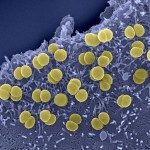Link to Pubmed [PMID] – 28314560
Vaccine 2017 04;35(16):2034-2041
BACKGROUND: Invasive meningococcal disease (IMD) is a major cause of bacterial meningitis and septicaemia although infection by some serogroups may be prevented through vaccination. We aimed to describe the epidemiology of IMD in EU/EEA countries during 2004-2014 to monitor serogroup- and age-specific trends, and compare country trends by the period of meningococcal C conjugate (MCC) vaccine introduction.
METHODS: We analysed IMD surveillance data by age, gender, serogroup, country and outcome. We estimated the percentage change in annual notification rate (NR), using linear regression analysis of the log of the annual NR. We grouped countries by the year they introduced MCC vaccination into their routine immunisation programmes.
RESULTS: The overall NR was 0.9/100 000 population, and decreased 6.6% (95%CI: -8.0%;-5.1%) annually. Infants had the highest NR (16.0/100 000), and there were decreasing trends in all age groups <50years. Serogroup B (SgB) caused 74% of all cases, and the majority of cases in all age groups. There were decreasing trends in SgB and serogroup C (SgC) and an increasing trend in serogroup Y. Countries that introduced MCC vaccination before, and between 2004 and 2014, had decreasing trends in NR of SgC, but not countries without routine MCC vaccination.
CONCLUSIONS: Our findings support evidence that routine MCC vaccination was the driving force behind the decreasing SgC trend. Vaccinating against SgB in the first year of life could help reduce the burden of IMD due to this serogroup. Changing serogroup-specific NR trends highlight the need for high-quality surveillance data to accurately assess the changing epidemiology of IMD, the effectiveness and impact of implemented vaccines, and the need for future vaccines.

